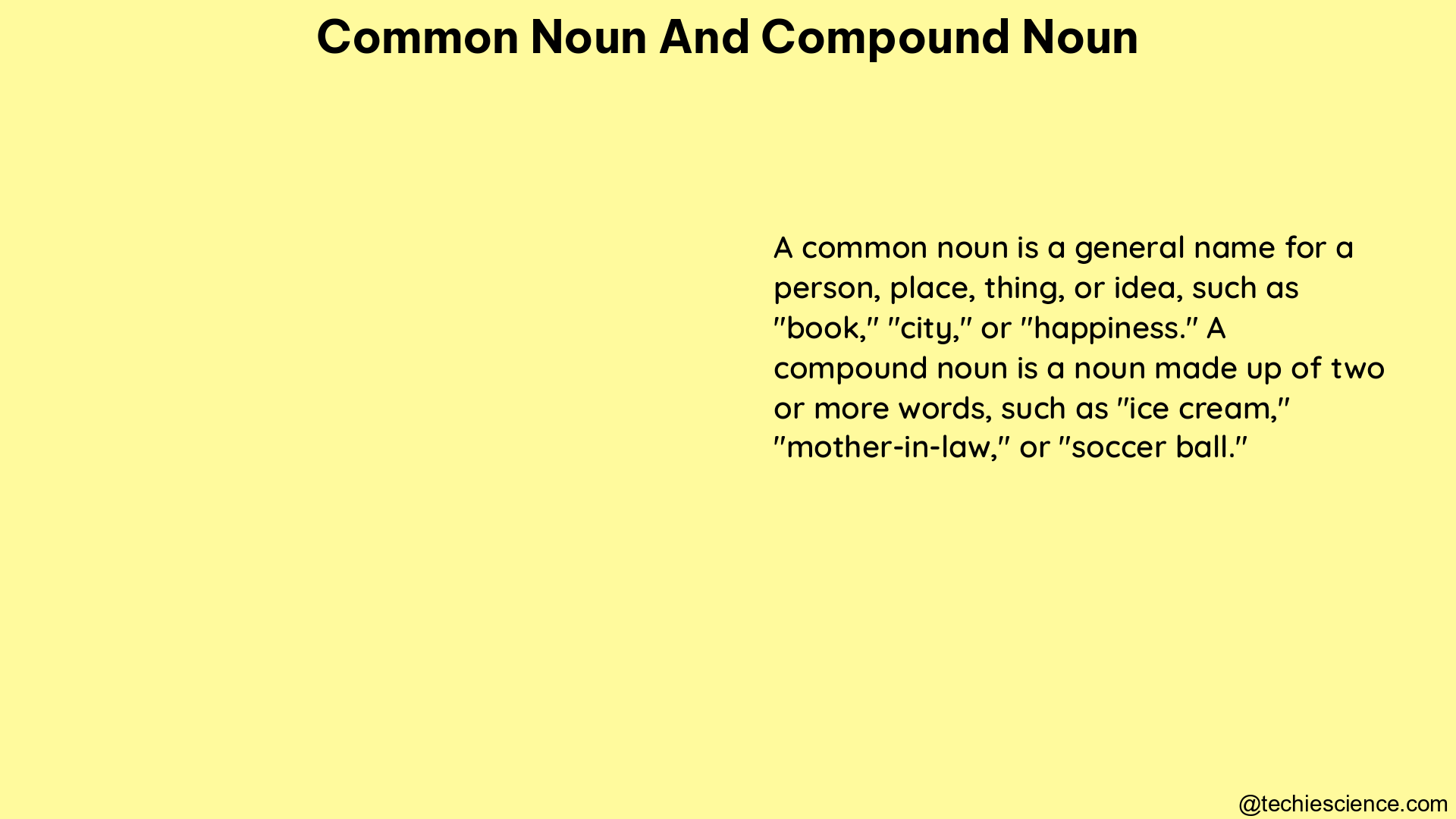Common nouns and compound nouns are two fundamental categories of nouns in the English language. Understanding the nuances and grammatical specifications of these noun types is crucial for effective communication, accurate expression, and mastering the English language.
Understanding Common Nouns
A common noun is a generic term used to describe a person, place, thing, or idea. It is not specific and can refer to any instance of the category it represents. Common nouns are not capitalized unless they appear at the beginning of a sentence or in a title.
Characteristics of Common Nouns
- Generality: Common nouns are general terms that can apply to any member of a particular category. They do not refer to a specific person, place, thing, or idea.
- No Capitalization: Common nouns are not capitalized, except when they appear at the beginning of a sentence or in a title.
- Plurality: Common nouns can be made plural by adding an “s” or “es” to the end of the word, depending on the spelling.
Examples of Common Nouns
Here are some examples of common nouns:
- Person: man, woman, child, student, teacher
- Place: city, park, school, hospital, beach
- Thing: book, chair, car, apple, computer
- Idea: happiness, freedom, love, justice, creativity
Understanding Compound Nouns

A compound noun, on the other hand, is a noun made up of two or more words that function together as a single unit. These words can be written as one word, separated by a hyphen, or as two separate words. Compound nouns often have a specific meaning that is different from the individual words that form them.
Characteristics of Compound Nouns
- Combination of Words: Compound nouns are formed by combining two or more words to create a new, single unit.
- Specific Meaning: The meaning of a compound noun is often different from the individual words that make it up.
- Varied Spelling: Compound nouns can be written as one word, with a hyphen, or as two separate words, depending on the specific usage and convention.
- Stress Pattern: In compound nouns, the stress usually falls on the first syllable, which helps distinguish them from adjectives with nouns.
- Plural Formation: When forming the plural of a compound noun, the primary noun is pluralized.
Examples of Compound Nouns
Here are some examples of compound nouns:
- Written as One Word: bedroom, toothbrush, firefighter, notebook, sunflower
- Written with a Hyphen: self-portrait, merry-go-round, well-being, mother-in-law, editor-in-chief
- Written as Separate Words: post office, real estate, ice cream, high school, bank account
Grammatical Specifications of Common Nouns and Compound Nouns
Stress Patterns
In compound nouns, the stress usually falls on the first syllable, which helps distinguish them from adjectives with nouns. For example, “greenhouse” (a place where plants are grown) versus “green house” (a house painted green).
Plural Formation
When forming the plural of a compound noun, the primary noun is pluralized. For example, “fisherman” becomes “fishermen,” and “brother-in-law” becomes “brothers-in-law”.
Hyphenation
Hyphens are used to connect words in compound nouns, especially when they contain suffixes or articles. However, the use of hyphens can vary depending on the context and individual choice.
Key Differences between Common Nouns and Compound Nouns
- Specificity: Common nouns are generic terms, while compound nouns are more specific and often have a unique meaning.
- Capitalization: Common nouns are not capitalized, except at the beginning of a sentence or in a title, while compound nouns may or may not be capitalized depending on their structure.
- Spelling: Compound nouns can be written as one word, with a hyphen, or as two separate words, while common nouns are typically single words.
- Stress Pattern: In compound nouns, the stress usually falls on the first syllable, while in common nouns, the stress pattern can vary.
- Plural Formation: When forming the plural of a compound noun, the primary noun is pluralized, while common nouns typically add an “s” or “es” to the end of the word.
Conclusion
Understanding the differences and grammatical specifications of common nouns and compound nouns is essential for effective communication and accurate expression in the English language. By mastering these concepts, you can enhance your writing, speaking, and overall language proficiency.
References
- EF United States. (n.d.). Compound nouns. Retrieved from https://www.ef.edu/english-resources/english-grammar/compound-nouns/
- Cambridge Grammar. (n.d.). Nouns: compound nouns. Retrieved from https://dictionary.cambridge.org/us/grammar/british-grammar/nouns-compound-nouns
- Lumen Learning. (n.d.). Categories of Nouns. Retrieved from https://courses.lumenlearning.com/suny-introtocollegecomp/chapter/text-categories-of-nouns/
- The Writing Center at UNC-Chapel Hill. (n.d.). Compound Nouns. Retrieved from https://writingcenter.unc.edu/tips-and-tools/compound-nouns/
- Purdue Online Writing Lab. (n.d.). Nouns. Retrieved from https://owl.purdue.edu/owl/general_writing/academic_writing/grammar/nouns.html

Hi…. I am Goutam Datta. I have completed a double M. A. in English and B. Ed. I am a creative writer. Currently, I am a part of the LambdaGeeks.